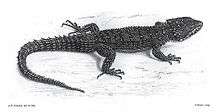Cordylus
| Cordylus | |
|---|---|
| | |
| Cordylus tropidosternum, tropical girdled lizard | |
| Scientific classification | |
| Kingdom: | Animalia |
| Phylum: | Chordata |
| Class: | Reptilia |
| Order: | Squamata |
| Family: | Cordylidae |
| Genus: | Cordylus Laurenti, 1768 |
The genus Cordylus (Sauria: Cordylidae) includes a wide variety of small- to medium-sized spiny lizards from Africa, collectively called girdle-tailed or girdled lizards. All are diurnal and ovoviviparous (live-bearing, without shelled eggs). Most species are rupicolous (rock-dwelling), while a few species are arboreal or live in burrows. They defend themselves with osteoderms (flat bony plates in the skin) and by quickly retreating into rock crevices or burrows. Many species live in groups and males defend territories.
Cordylids are generally listed under CITES Appendix II. They are not necessarily threatened with extinction, but trade is controlled to prevent overexploitation. Some species of Cordylus have limited ranges and may be threatened with habitat destruction or over collecting for the pet trade.
Classification
Broadley (2006) recognized 47 species in the genus Cordylus, including eight species originally placed in the genus Pseudocordylus ( P. fasciatus, P. langi, P. melanotus, P. microlepidotus, P. nebulosus, P. spinosus, P. subvirdis, and P. transvaalensis) and Hemicordylus capensis. The greatest diversity of cordylids is in South Africa, with a few species found in Angola and eastern Africa as far north as Ethiopia. Other members of the Cordylidae are the genera Chamaesaura (a group of legless lizards from southern and eastern Africa) and Platysaurus. The sister group of Cordylidae is the plated lizards, family Gerrhosauridae.
In 2011, a study based on the molecular phylogeny of the family suggested several species traditionally included in Cordylus should be moved to other genera: Hemicordylus (for capensis and nebulosus), Karusasaurus (for jordani and polyzonus), Namazonurus (for campbelli, lawrenci, namaquensis, peersi and pustulatus), Ninurta (for coeruleopunctatus), Ouroborus (for cataphractus) and Smaug (for breyeri, giganteus, mossambicus, regius, vandami and warreni).[1] This classification is supported by the Reptile Database where only 21 species remain in Cordylus.[2]
Genus Cordylus (as traditionally defined, sensu lato)
- Angolan girdled lizard, Cordylus angolensis
- Dwarf Karoo girdled lizard, Cordylus aridus
- Barberton girdled lizard, Cordylus barbertonensis
- Maasai girdled lizard, Cordylus beraduccii
- Waterberg girdled lizard, Cordylus breyeri
- Campbell's girdled lizard, Cordylus campbelli
- False girdled lizard, Cordylus capensis or Hemicordylus capensis
- Armadillo girdled lizard, Cordylus cataphractus

- Cloete's girdled lizard, Cordylus cloetei
- Blue-spotted girdled lizard, Cordylus coeruleopunctatus or Ninurta coeruleopunctatus
- Cape girdled lizard, Cordylus cordylus
- Zoutpansberg girdled lizard, Cordylus depressus
- Eastern Cape crag lizard, Cordylus fasciatus
- Giant girdled lizard, Cordylus giganteus

- Rooiberg girdled lizard, Cordylus imkeae
- Limpopo girdled lizard, Cordylus jonesii
- Jordan's girdled lizard, Cordylus jordani
- Lang's crag lizard, Cordylus langi
- Lawrence's girdled lizard, Cordylus lawrenci
- Machadoe's girdled lizard, Cordylus machadoi
- Coastal spiny-tailed lizard, Cordylus macropholis
- McLachlan's girdled lizard, Cordylus mclachlani
- Mecula girdled lizard, Cordylus meculae
- Highveld crag lizard, Cordylus melanotus
- Western Cape crag lizard, Cordylus microlepidotus
- Dwarf girdled lizard, Cordylus minor
- Mozambique girdled lizard, Cordylus mossambicus
- Namaqua girdled lizard, Cordylus namaquensis
- Dwarf crag lizard, Cordylus nebulosus
- Black girdled lizard, Cordylus niger

- Cordylus nyikae
- Oelofsen's girdled lizard, Cordylus oelofseni
- Hewitt's spiny-tailed lizard, Cordylus peersi
- African spiny-tailed lizard, Cordylus polyzonus
- Herero girdled lizard, Cordylus pustulatus
- Rhodesian girdled lizard, Cordylus rhodesianus
- Cordylus rivae
- Prickly girdled lizard, Cordylus spinosus
- Drakensberg crag lizard, Cordylus subviridis
- Tasman's girdled lizard, Cordylus tasmani
- Northern crag lizard, Cordylus transvaalensis
- East African spiny-tailed lizard, Cordylus tropidosternum
- Ukinga girdled lizard, Cordylus ukingensis
- Van Dam's girdled lizard, Cordylus vandami
- Reichenow's spiny-tailed lizard, Cordylus vittifer
- Warren's girdled lizard, Cordylus warreni
References
- ↑ Stanley, Edward L.; Bauer, Aaron M.; Jackman, Todd R.; Branch, William R.; Mouton, P. Le Fras N. (2011). "Between a rock and a hard polytomy: Rapid radiation in the rupicolous girdled lizards (Squamata: Cordylidae)" (PDF). Molecular Phylogenetics and Evolution. 58 (1): 53–70. doi:10.1016/j.ympev.2010.08.024.
- ↑ Uetz, Peter et al. (2014). The Reptile Database. Retrieved 11 November 2014.
- Branch, Bill. (2004). Field Guide to Snakes and other Reptiles of Southern Africa. Third Revised edition, Second impression. Sanibel Island, Florida: Ralph Curtis Books Publishing. 399 pp. ISBN 0-88359-042-5. (Genus Cordylus, pp. 185–186).
- Broadley DG. (2006).[1]
- FitzSimons VF. (1943). The Lizards of South Africa. Pretoria: Transvaal Museum Memoir.
- Spawls S, Howell K, Drewes R, Ashe J. (2002). A Field Guide to the Reptiles of East Africa. San Diego: Academic Press. 543 pp.
Further reading
- Laurenti JN. (1768). Specimen medicum, exhibens synopsin reptilium emendatam cum experimentis circa venena et antidota reptilium austriacorum. Vienna: "Joan. Thom. Nob. de Trattnern". 214 pp. + Plates I- V. (Genus Cordylus, p. 51).
External links
- ↑ (PDF) https://web.archive.org/web/20110607065817/http://www.cites.org/common/com/NC/tax_ref/Cordylus_CoP14_update.pdf. Archived from the original (PDF) on June 7, 2011. Retrieved October 19, 2007. Missing or empty
|title=(help)
